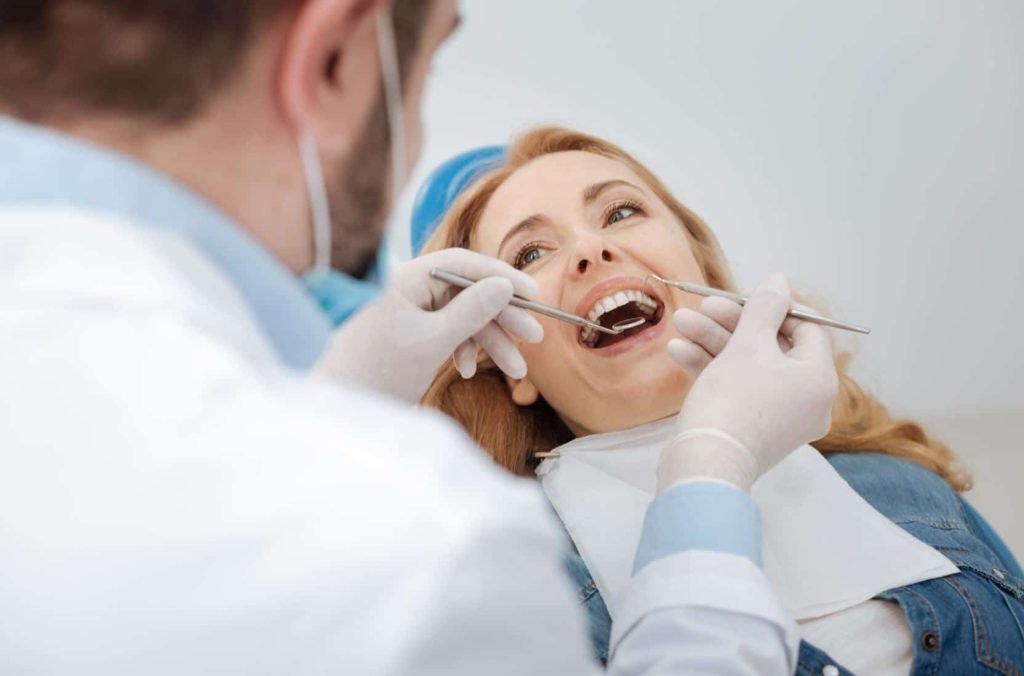Gum disease is a prevalent oral health condition that affects many people worldwide. It is a bacterial infection that affects the gums, bone, and tissues supporting the teeth. This condition can lead to tooth loss if left untreated, making it crucial to take the necessary steps to prevent it. Proper brushing and flossing techniques are essential in preventing gum disease, and they play a significant role in maintaining good oral hygiene. Let’s explore in detail how to prevent gum disease with brushing and flossing
Understanding how gum disease develops and the role of plaque buildup in its progression is crucial to prevent it. Plaque is a sticky film that forms on teeth and is made up of bacteria and food particles. When not removed through proper oral hygiene practices like brushing and flossing, plaque can cause inflammation of gums and lead to gum disease. In this article, we will discuss the importance of brushing twice a day, choosing the right toothbrush, proper brushing techniques, types of flossing tools, how to floss correctly, and additional oral hygiene tips to help prevent gum disease.

The Dangers of Gum Disease
Gum disease poses a significant risk to oral health and can lead to severe complications. This condition starts when plaque builds up along the gum line, causing inflammation and irritation. If left untreated, it can progress to periodontitis, a more severe form of gum disease that attacks the bone and tissues supporting the teeth, leading to tooth loss.
Apart from tooth loss, gum disease can also increase the risk of developing systemic diseases such as heart disease, stroke, and diabetes. Studies have shown that the bacteria responsible for gum disease can enter the bloodstream, causing inflammation that can affect other organs in the body. Therefore, it is crucial to take proper care of your oral health to prevent gum disease and its associated complications. Understanding plaque buildup is the first step towards this goal.

Understanding Plaque Buildup
The accumulation of bacterial biofilm on teeth surfaces, commonly known as dental plaque, is a major contributing factor to oral health problems. Plaque buildup occurs when bacteria feed on sugary foods and drinks, producing acid that erodes tooth enamel and irritates the gum tissue. Over time, this can lead to cavities, gum disease, and even tooth loss.
Moreover, plaque buildup is not limited to the visible surfaces of teeth. It can also accumulate on the tongue, the roof of the mouth, and in between teeth, making it difficult to remove with brushing alone. Therefore, it is essential to adopt a comprehensive oral hygiene routine that includes regular flossing, the use of mouthwash, and visits to the dentist for professional cleanings. With proper care, it is possible to prevent and reverse the effects of plaque buildup. To this end, the importance of brushing twice a day cannot be overstated.
The Importance of Brushing Twice a Day
Maintaining oral hygiene by brushing twice a day is crucial in preventing the accumulation of dental plaque and its associated adverse effects. Brushing twice a day helps to remove the food particles that accumulate in the mouth after meals, which, if left unattended, can lead to the growth of harmful bacteria. The bacteria can then produce acids that attack the teeth and gums, leading to cavities, gum disease, and other dental problems. Brushing twice a day helps to remove the harmful bacteria and their byproducts, which in turn keeps the mouth clean and healthy.
Moreover, brushing twice a day helps to maintain fresh breath, which is an essential aspect of good oral hygiene. Bad breath, also known as halitosis, is often caused by the accumulation of food particles, bacteria, and other debris in the mouth. Brushing twice a day helps to remove these particles and bacteria, thus preventing bad breath. In addition, regular brushing can help to prevent staining of the teeth by removing surface stains and preventing the buildup of new ones. Therefore, it is important to maintain a regular brushing routine to keep the mouth clean, healthy, and fresh. In the subsequent section, we will discuss the importance of choosing the right toothbrush.

Choosing the Right Toothbrush
Selecting the most suitable toothbrush is vital in preserving optimal oral health and preventing the accumulation of harmful bacteria in the mouth. Toothbrushes come in a wide array of shapes, sizes, and bristle types, making it important to choose one that will effectively clean teeth and gums without causing damage. When selecting a toothbrush, it is important to consider the size of the brush head, the type of bristles, and the handle grip. A small brush head is ideal for reaching tight spaces in the mouth, while soft bristles are gentle on the gums and teeth. A comfortable handle grip ensures that the toothbrush is easy to hold and use.
Proper brushing technique is essential for removing plaque and preventing gum disease. One effective technique is the circular motion technique, where the toothbrush is held at a 45-degree angle to the gums and moved in small circular motions. Another technique is the back-and-forth technique, where the brush is moved in short back-and-forth strokes. It is important to brush all surfaces of the teeth, including the back and sides, and to brush for at least two minutes twice a day. Regularly replacing toothbrushes every three to four months is also important for maintaining optimal oral health.

Proper Brushing and Flossing Techniques
Achieving optimal oral health requires a mastery of effective brushing methods that ensure all surfaces of the teeth are reached and cleaned thoroughly. The first step is to use a soft-bristled toothbrush and apply enough pressure to remove plaque without damaging the enamel or gums. It is important to brush at least twice a day, for two minutes each time, using gentle circular motions. Pay attention to the front, back, and chewing surfaces of the teeth, as well as the tongue and the roof of the mouth. To prevent gum disease, it is essential to brush the gum line, where bacteria can accumulate and cause inflammation.
Proper brushing technique can help prevent cavities, gum disease, bad breath, and other oral health problems. However, brushing alone is not enough to keep the mouth healthy. In addition to regular dental checkups, it is essential to floss at least once a day to remove food particles and plaque from between the teeth. Flossing can also help stimulate the gums and promote blood flow, which can improve their health and appearance. By combining proper brushing and flossing techniques, individuals can achieve optimal oral health and maintain a confident smile.
One of the most overlooked aspects of oral hygiene is the regular use of dental floss. While brushing is vital for removing plaque and food particles from the surface of the teeth, flossing reaches the tight spaces between the teeth and the gum line that a toothbrush cannot reach. Flossing helps to remove leftover food particles and plaque that have accumulated in these areas and can cause gum disease and tooth decay. Regular flossing can also help to prevent bad breath by removing the bacteria that cause it.
Apart from removing plaque and food particles, flossing has additional benefits. It helps to stimulate the gums, increasing blood flow to the area, which is essential for maintaining healthy gums. Flossing can also help to prevent cavities by removing plaque before it can cause any damage. With all these benefits, it is clear that flossing is as important as brushing. In the next section, we will discuss the different types of flossing tools that are available and how to choose the right one.

Types of Flossing Tools
Understanding the different types of flossing tools available is crucial for maintaining optimal oral health. Traditional string floss is the most common and widely used tool. It is affordable and easy to find at any drugstore or grocery store. It comes in waxed or unwaxed varieties, and it can be flavored or unflavored. Another type of flossing tool is the floss pick, which is a small plastic tool that holds a short piece of floss between two prongs. The floss pick is convenient and easy to use, making it a popular choice for those who are always on the go. Additionally, water flossers, also known as oral irrigators, use a stream of water to clean between teeth and along the gum line. They are effective at removing plaque and food particles, but they can be expensive and require access to a power outlet.
Knowing the different types of flossing tools available can help you choose the best one for your needs. Once you have selected a tool, it is important to learn how to use it correctly to ensure maximum effectiveness. In the next section, we will discuss the proper technique for flossing to prevent gum disease and maintain a healthy smile.
How to Floss Correctly?
Flossing is an essential part of maintaining good oral hygiene. As discussed earlier, there are various types of flossing tools available, and it is essential to choose the one that best suits your needs. However, it is equally important to know how to floss correctly.
To floss correctly, begin by breaking off about 18 inches of floss and winding most of it around one of your middle fingers. Wind the remaining floss around the same finger of your other hand to take up the used floss as you go. Hold the floss tightly between your thumb and forefinger and gently insert it between your teeth. Curve the floss into a C-shape against the side of the tooth, making sure to go beneath the gum-line. Gently move the floss up and down, rubbing it against the side of each tooth. Be sure to use a clean section of floss as you move from tooth to tooth.
In addition to proper brushing and flossing, there are other essential oral hygiene tips that you should follow to maintain healthy teeth and gums. These tips include using mouthwash, avoiding smoking, limiting sugary and acidic foods and drinks, and visiting your dentist regularly for check-ups and cleanings. By following these tips, you can ensure that you have a healthy and beautiful smile for years to come.

Additional Oral Hygiene Tips
Maintaining good oral hygiene requires more than just brushing and flossing. Additional oral hygiene tips include using mouthwash, limiting sugary and acidic foods and drinks, avoiding smoking, and regular dental check-ups and cleanings. Using mouthwash can help kill any remaining bacteria in the mouth and freshen breath. Limiting sugary and acidic foods and drinks can prevent erosion of tooth enamel and the growth of harmful bacteria. Avoiding smoking can reduce the risk of gum disease, oral cancer, and tooth loss. Regular dental check-ups and cleanings can identify any potential issues early on and prevent them from becoming more serious problems.
One important factor to note is that gum disease is preventable with proper oral hygiene practices. However, if gum disease does develop, seeking professional help from a dentist or periodontist can be crucial in preventing further damage. By getting regular check-ups and cleanings, any potential issues can be identified early on and treated before they become more serious problems. In the next section, we will discuss how seeking professional help for gum disease can be an important step in maintaining good oral health.
Seeking Professional Help for Gum Disease
Seeking professional help from a dentist or periodontist can effectively treat gum disease and prevent further damage to oral health. Gum disease is a serious condition that can lead to tooth loss and other health problems if left untreated. Professional help is necessary when the disease has progressed beyond the early stages. A dentist or periodontist can perform a thorough examination of the mouth and gums regrowth treatment to determine the extent of the disease. They can then recommend appropriate treatment options, which may include deep cleaning, medication, surgery, or a combination of these methods.
In addition to treating gum disease, a dental professional can also provide guidance on how to prevent it from recurring. They can recommend proper brushing and flossing techniques, as well as advise on lifestyle changes that can improve oral health. Regular dental check-ups and cleanings are also essential for maintaining healthy gums and teeth. Seeking professional help is a crucial step in preventing and treating gum disease, and can ultimately lead to a healthier and happier life.

Frequently Asked Questions
Can gum disease be cured completely?
Gum disease can be effectively treated, but there is no definitive cure. Proper dental hygiene, including brushing and flossing, can help prevent and manage symptoms. Regular dental check-ups and professional cleanings are also recommended.
Are there any natural remedies for gum disease?
Several natural remedies have been suggested to help manage gum disease, including oil pulling, aloe vera, green tea, and probiotics. However, more research is needed to determine their effectiveness and potential side effects.
How often should I replace my toothbrush?
To maintain optimal oral hygiene, it is recommended to replace your toothbrush every three to four months. This ensures that the bristles are still effective at removing plaque and bacteria, reducing the risk of tooth decay and gum disease.
What are the common symptoms of gum disease?
Common symptoms of gum disease include red and swollen gums, bleeding while brushing or flossing, receding gums, persistent bad breath, and loose teeth. It is important to consult a dental professional if these symptoms persist.
Can gum disease affect other parts of the body?
Gum disease is linked to various health conditions like heart disease, stroke, and diabetes. The bacteria in the mouth can spread to other parts of the body and cause inflammation, leading to these health issues.
Conclusion
In conclusion, gum disease is a serious condition that requires proper oral hygiene to prevent. Understanding plaque buildup and the importance of brushing twice a day can help in preventing the onset of gum disease. Choosing the right toothbrush and using the proper brushing and flossing techniques can also help in maintaining oral hygiene. Flossing is another crucial aspect of oral hygiene, and there are various types of flossing tools available. Knowing how to floss correctly is necessary for preventing gum disease.
In addition to these techniques, following a healthy diet, avoiding tobacco products, and seeking professional help for gum disease are essential. By adopting these practices, individuals can maintain good oral health and prevent gum disease. It is crucial to remember that prevention is always better than cure when it comes to oral health. Therefore, taking care of one’s teeth and gums should be a top priority. Following these simple steps can help in preventing gum disease and maintaining good oral hygiene.


